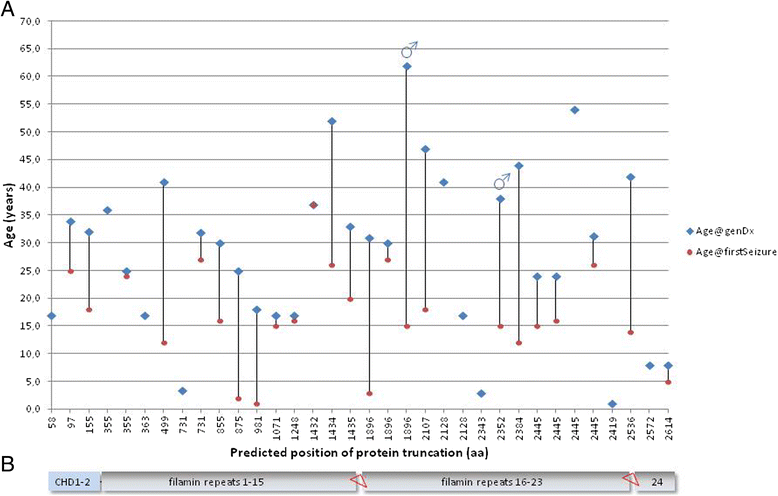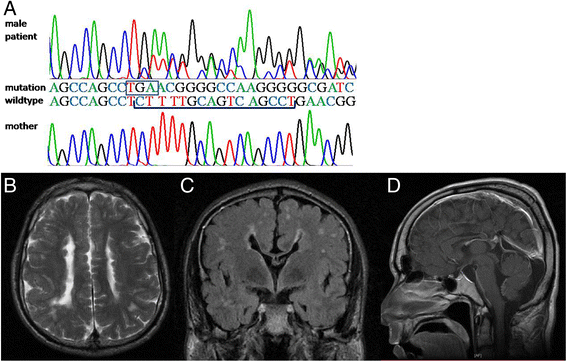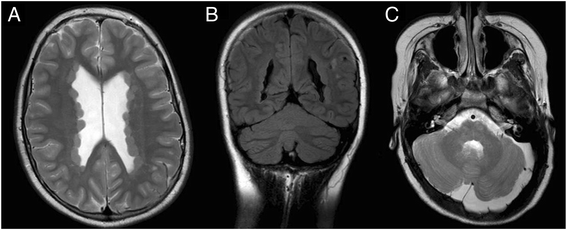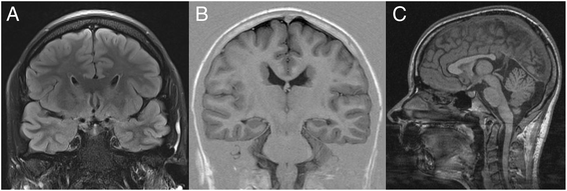47 patients with FLNA associated periventricular nodular heterotopia - PubMed (original) (raw)
doi: 10.1186/s13023-015-0331-9.
Burkhard Kasper 2, Axel Bohring 3, Frank Rutsch 4, Gerhard Kluger 5, Sabine Hoffjan 6, Stephanie Spranger 7, Anne Behnecke 8, Andreas Ferbert 9, Andreas Hahn 10, Barbara Oehl-Jaschkowitz 11, Luitgard Graul-Neumann 12, Katharina Diepold 13, Isolde Schreyer 14, Matthias K Bernhard 15, Franziska Mueller 16, Ulrike Siebers-Renelt 17, Ana Beleza-Meireles 18, Goekhan Uyanik 19, Sandra Janssens 20, Eugen Boltshauser 21, Juergen Winkler 22, Gerhard Schuierer 23, Ute Hehr 24
Affiliations
- PMID: 26471271
- PMCID: PMC4608144
- DOI: 10.1186/s13023-015-0331-9
47 patients with FLNA associated periventricular nodular heterotopia
Max Lange et al. Orphanet J Rare Dis. 2015.
Abstract
Background: Heterozygous loss of function mutations within the Filamin A gene in Xq28 are the most frequent cause of bilateral neuronal periventricular nodular heterotopia (PVNH). Most affected females are reported to initially present with difficult to treat seizures at variable age of onset. Psychomotor development and cognition may be normal or mildly to moderately impaired. Distinct associated extracerebral findings have been observed and may help to establish the diagnosis including patent ductus arteriosus Botalli, progressive dystrophic cardiac valve disease and aortic dissection, chronic obstructive lung disease or chronic constipation. Genotype-phenotype correlations could not yet be established.
Methods: Sanger sequencing and MLPA was performed for a large cohort of 47 patients with Filamin A associated PVNH (age range 1 to 65 years). For 34 patients more detailed clinical information was available from a structured questionnaire and medical charts on family history, development, epileptologic findings, neurological examination, cognition and associated clinical findings. Available detailed cerebral MR imaging was assessed for 20 patients.
Results: Thirty-nine different FLNA mutations were observed, they are mainly truncating (37/39) and distributed throughout the entire coding region. No obvious correlation between the number and extend of PVNH and the severity of the individual clinical manifestation was observed. 10 of the mutation carriers so far are without seizures at a median age of 19.7 years. 22 of 24 patients with available educational data were able to attend regular school and obtain professional education according to age.
Conclusions: We report the clinical and mutation spectrum as well as MR imaging for a large cohort of 47 patients with Filamin A associated PVNH including two adult males. Our data are reassuring in regard to psychomotor and cognitive development, which is within normal range for the majority of patients. However, a concerning median diagnostic latency of 17 to 20 years was noted between seizure onset and the genetic diagnosis, intensely delaying appropriate medical surveillance for potentially life threatening cardiovascular complications as well as genetic risk assessment and counseling prior to family planning for this X-linked dominant inherited disorder with high perinatal lethality in hemizygous males.
Figures
Fig. 1
a Patient age at onset of the seizure disorder (red) and at genetic diagnosis (blue) with diagnostic latency (black line); b schematic structure of the corresponding Filamin A protein (not to scale) with the two NH2-terminal actin binding calponin homology domains (CHD1-2) and 24 immunoglobulin-like filamin repeat domains interrupted by two hinge regions (red triangles)
Fig. 2
a High grade mosaic FLNA mutation c.7055_7070delCTTTTGCAGTCAGCCT in peripheral blood (upper sequence) of a 36 year old male patient 29 with normal male karyotype 46,XY, resulting in the nonsense mutation p.Ser2352*, novel stop codon boxed. Wildtype sequence of the healthy mother below. b–d cerebral MR imaging demonstrating extended PVNH bilaterally (b and c), diffuse white matter abnormalities and inward rotated anterior ventricular horns (c), hypoplastic corpus callosum and large mega cisterna magna (d)
Fig. 3
a-c cMR imaging of 11 year old female patient 37 with complex FLNA associated phenotype including severe connective tissue disorder with gastrointestinal, cardiac and vascular manifestation, resulting from heterozygous C-terminal FLNA frameshift mutation c.7840dupT. a and b extended cortexisodense PVNH bilaterally; (b) white matter abnormalities and (c) large mega cisterna magna
Fig. 4
a, b coronal cMR imaging of the anterior ventricular horns with normal configuration (a) in 27 year old female patient 39 with PVNH only along the central and occipital parts of the lateral ventricular walls and (b) with the more frequently observed anterior heterotopia and abnormal inward rotation in 16 year old patient 16. c Sagittal cMR imaging of 17 year old patient 26 with characteristically shortened hypoplastic corpus callosum and large mega cisterna magna
Similar articles
- Phenotypic and imaging features of FLNA-negative patients with bilateral periventricular nodular heterotopia and epilepsy.
Fallil Z, Pardoe H, Bachman R, Cunningham B, Parulkar I, Shain C, Poduri A, Knowlton R, Kuzniecky R; EPGP Investigators. Fallil Z, et al. Epilepsy Behav. 2015 Oct;51:321-7. doi: 10.1016/j.yebeh.2015.07.041. Epub 2015 Sep 2. Epilepsy Behav. 2015. PMID: 26340046 Free PMC article. - A novel truncating mutation in FLNA causes periventricular nodular heterotopia, Ehlers-Danlos-like collagenopathy and macrothrombocytopenia.
Ieda D, Hori I, Nakamura Y, Ohshita H, Negishi Y, Shinohara T, Hattori A, Kato T, Inukai S, Kitamura K, Kawai T, Ohara O, Kunishima S, Saitoh S. Ieda D, et al. Brain Dev. 2018 Jun;40(6):489-492. doi: 10.1016/j.braindev.2018.01.010. Epub 2018 Feb 12. Brain Dev. 2018. PMID: 29449050 - Phenotypic manifestations in _FLNA_-related periventricular nodular heterotopia: a case report and review of the literature.
Loft Nagel J, Jønch AE, Nguyen NTTN, Bygum A. Loft Nagel J, et al. BMJ Case Rep. 2022 Apr 12;15(4):e247268. doi: 10.1136/bcr-2021-247268. BMJ Case Rep. 2022. PMID: 35414575 Free PMC article. Review. - Sporadic periventricular nodular heterotopia: Classification, phenotype and correlation with Filamin A mutations.
Liu W, Yan B, An D, Xiao J, Hu F, Zhou D. Liu W, et al. Epilepsy Res. 2017 Jul;133:33-40. doi: 10.1016/j.eplepsyres.2017.03.005. Epub 2017 Apr 4. Epilepsy Res. 2017. PMID: 28411558 - A review of filamin A mutations and associated interstitial lung disease.
Sasaki E, Byrne AT, Phelan E, Cox DW, Reardon W. Sasaki E, et al. Eur J Pediatr. 2019 Feb;178(2):121-129. doi: 10.1007/s00431-018-3301-0. Epub 2018 Dec 13. Eur J Pediatr. 2019. PMID: 30547349 Review.
Cited by
- Filamin A gene mutation in an infant with progressive pulmonary emphysema, periventricular nodular heterotopia and congenital heart disease.
Khera S, Jauhari S, Pattanayak S, Choubey M. Khera S, et al. BMJ Case Rep. 2024 Jan 4;17(1):e257676. doi: 10.1136/bcr-2023-257676. BMJ Case Rep. 2024. PMID: 38176754 No abstract available. - A novel missense mutation in the HECT domain of NEDD4L identified in a girl with periventricular nodular heterotopia, polymicrogyria and cleft palate.
Kato K, Miya F, Hori I, Ieda D, Ohashi K, Negishi Y, Hattori A, Okamoto N, Kato M, Tsunoda T, Yamasaki M, Kanemura Y, Kosaki K, Saitoh S. Kato K, et al. J Hum Genet. 2017 Sep;62(9):861-863. doi: 10.1038/jhg.2017.53. Epub 2017 May 18. J Hum Genet. 2017. PMID: 28515470 - Heterogeneous Pulmonary Phenotypes in Filamin A Mutation-Related Lung Disease.
Shah AS, Black ED, Simon DM, Gambello MJ, Garber KB, Iannucci GJ, Riedesel EL, Kasi AS. Shah AS, et al. Pediatr Allergy Immunol Pulmonol. 2021 Mar;34(1):7-14. doi: 10.1089/ped.2020.1280. Pediatr Allergy Immunol Pulmonol. 2021. PMID: 33734874 Free PMC article. - Cardiovascular and connective tissue disorder features in FLNA-related PVNH patients: progress towards a refined delineation of this syndrome.
Billon C, Adham S, Hernandez Poblete N, Legrand A, Frank M, Chiche L, Zuily S, Benistan K, Savale L, Zaafrane-Khachnaoui K, Brehin AC, Bal L, Busa T, Fradin M, Quelin C, Chesneau B, Wahl D, Fergelot P, Goizet C, Mirault T, Jeunemaitre X, Albuisson J; Bordeaux-cohort collaborators. Billon C, et al. Orphanet J Rare Dis. 2021 Dec 4;16(1):504. doi: 10.1186/s13023-021-02128-1. Orphanet J Rare Dis. 2021. PMID: 34863227 Free PMC article. - Diagnostic workup of childhood interstitial lung disease.
Nathan N, Griese M, Michel K, Carlens J, Gilbert C, Emiralioglu N, Torrent-Vernetta A, Marczak H, Willemse B, Delestrain C, Epaud R; ERS CRC chILD-EU group. Nathan N, et al. Eur Respir Rev. 2023 Feb 21;32(167):220188. doi: 10.1183/16000617.0188-2022. Print 2023 Mar 31. Eur Respir Rev. 2023. PMID: 36813289 Free PMC article. Review.
References
MeSH terms
Substances
Supplementary concepts
LinkOut - more resources
Full Text Sources
Other Literature Sources
Medical
Miscellaneous



